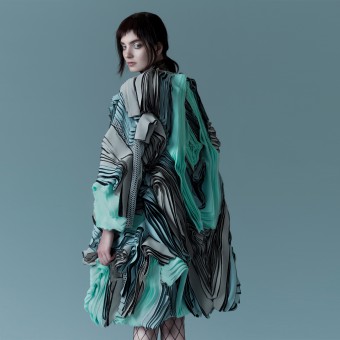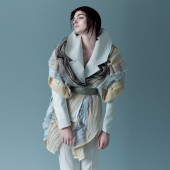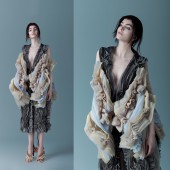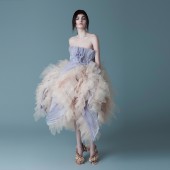
| THE AWARD |
| CATEGORIES |
| REGISTRATION |
| SUBMIT YOUR WORK |
| ENTRY INSTRUCTIONS |
| TERMS & CONDITIONS |
| PUBLICATIONS |
| DATES & FEES |
| METHODOLOGY |
| CONTACT |
| WINNERS |
| PRESS ROOM |
| GET INVOLVED |
| DESIGN PRIZE |
| DESIGN STORE |
| THE AWARD | JURY | CATEGORIES | REGISTRATION | PRESS | WINNERS | PUBLICATIONS | ENTRY INSTRUCTIONS |
Traces Womenswear Collection by RONG ZHANG |
Home > Winners > Design #58304 >Interview |
 |
|
FS: What is the main principle, idea and inspiration behind your design?
RZ: 'Traces' collection shows intricately crafted, multi-layered garments and explorations into digital printing, digital embroidery and elastic material weaving, and creates thought-provoking silhouettes through a conscious layering textiles to represent the constraint of the Chinese examinations. Themes such as the exam papers, Chinese youth uniforms, Victorian costume details, Mai_68 student movement and artworks from Susan Hefuna and Maurizio Cattelan have been developed in 'Traces' collection. The ideology is that when you erase the traces, you destroy beauty. Luck and Misfortune comes in turn. The things you experienced, no matter good or bad, they are part of your body.
FS: What has been your main focus in designing this work? Especially what did you want to achieve?
RZ: Material experimenting The ideology is that when you erase the traces, you destroy beauty. Luck and Misfortune comes in turn. The things you experienced, no matter good or bad, they are part of your body.
FS: What are your future plans for this award winning design?
RZ: Transforming this collection into Ready to Wear collection
FS: How long did it take you to design this particular concept?
RZ: Half Year
FS: Why did you design this particular concept? Was this design commissioned or did you decide to pursuit an inspiration?
RZ: The collection’s concept goes against the over-simplified garments in mass production, and brings back the craftsmanship with the contemporary aesthetic.
FS: Is your design being produced or used by another company, or do you plan to sell or lease the production rights or do you intent to produce your work yourself?
RZ: I would like to collaborate with people who can develop my designs further.
FS: What made you design this particular type of work?
RZ: At first sight, the collection unfolds a fusion of craftsmanship, casual silhouettes and condense, flowing feelings. The layering fabric manipulation and netting fabric indicate the pressure of Chinese high school exam and constraint of breathe. The fabric manipulation ideas develop more innovative structures and shapes to my collection through draping.
FS: Where there any other designs and/or designers that helped the influence the design of your work?
RZ: Themes such as the exam papers, Chinese youth uniforms, Victorian costume details, Mai_68 student movement and artworks from Susan Hefuna and Maurizio Cattelan have inspired my 'Traces' collection.
FS: Who is the target customer for his design?
RZ: used for ceremonies and performances
FS: What sets this design apart from other similar or resembling concepts?
RZ: Start from my personal background and mood, with my performances, which develop my whole design process
FS: How did you come up with the name for this design? What does it mean?
RZ: The ideology is that when you erase the traces, you destroy beauty. Luck and Misfortune comes in turn. The things you experienced, no matter good or bad, they are part of your body.
FS: Which design tools did you use when you were working on this project?
RZ: sketchbook, PS, AI, sewing machine, lots of fabric experimenting.
FS: What is the most unique aspect of your design?
RZ: Starting waving the colorful elastic bands on the netting fabric, and transformed the 3D waving fabric into 2D digital printing. Moving on, I used digital printing images to develop new shapes and different fabric manipulation like the layering organza, the pearling edge georgette.
FS: Who did you collaborate with for this design? Did you work with people with technical / specialized skills?
RZ: Photographer Dasha Denger, Model:Bryn Baughman from Ford Models, Muah:Shannon Rodriguez Artistry
FS: What is the role of technology in this particular design?
RZ: bias cutting and the pearling edge sewing technique
FS: Is your design influenced by data or analytical research in any way? What kind of research did you conduct for making this design?
RZ: Themes such as the exam papers, Chinese youth uniforms, Victorian costume details, Mai_68 student movement and artworks from Susan Hefuna and Maurizio Cattelan have been developed in 'Traces' collection.
FS: What are some of the challenges you faced during the design/realization of your concept?
RZ: how to balance the weight of different fabric and colors.
FS: How did you decide to submit your design to an international design competition?
RZ: let more people to see and evaluate my designs.
FS: What did you learn or how did you improve yourself during the designing of this work?
RZ: how to make common fabric looks different?
FS: Thank you for providing us with this opportunity to interview you.
A' Design Award and Competitions grants rights to press members and bloggers to use parts of this interview. This interview is provided as it is; DesignPRWire and A' Design Award and Competitions cannot be held responsible for the answers given by participating designers.
| SOCIAL |
| + Add to Likes / Favorites | Send to My Email | Comment | View Press-Release |




